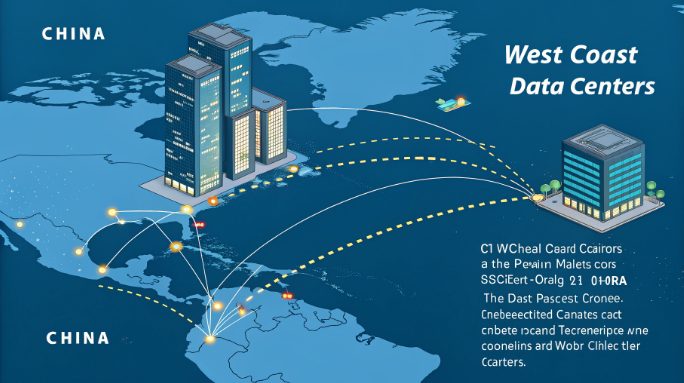Why Choose US Data Center Close to China?

For tech professionals managing China-facing operations, selecting the right US data center location is crucial for optimal performance. US West Coast hosting facilities have emerged as the strategic choice, offering superior network connectivity and reduced latency for Asian markets. This technical analysis explores why geographical proximity matters in server infrastructure decisions and how it impacts your system architecture.
West Coast Data Center Geographic Advantages
Los Angeles and Seattle data centers leverage their Pacific Rim position, connecting directly to major Asian networks through submarine cable systems like TPE, NCP, and Unity. These facilities sit at critical junction points where multiple tier-1 networks converge, creating robust connectivity options. The geodesic distance between LA and Shanghai is approximately 10,000 km – significantly shorter than east coast routes.
Key submarine cable systems supporting trans-Pacific connectivity include:
- Trans-Pacific Express (TPE): 5,600 miles capacity
- New Cross Pacific (NCP): 80Tbps design capacity
- FASTER Cable System: 60Tbps bandwidth
- Asia-America Gateway (AAG): Enhanced redundancy
- Pacific Light Cable Network (PLCN): Latest generation infrastructure
Technical Benefits of Proximity
Network performance metrics demonstrate clear advantages for West Coast colocation. Average latency to mainland China typically ranges from 120-150ms, compared to 180-220ms from East Coast facilities. This 30-40% reduction in round-trip time (RTT) directly impacts application responsiveness and user experience.
Critical performance improvements include:
- Reduced packet loss rates by up to 45%
- Lower jitter measurements averaging 8-12ms
- Improved TCP window scaling efficiency
- Enhanced congestion control response
- Better Quality of Service (QoS) management
Network Architecture Deep Dive
Modern West Coast data centers employ advanced backbone architectures that optimize routing efficiency and reliability. The infrastructure typically includes:
- Direct peering with major Chinese ISPs including China Telecom, China Unicom, and China Mobile
- Redundant 100GbE uplinks with automatic failover
- BGP anycast routing for load distribution
- Hot-potato routing optimization for minimal latency
- Advanced traffic engineering with MPLS
Real-world Performance Analysis
Benchmark testing across multiple workloads reveals consistent advantages:
- Database queries: 25-35% faster response times with improved consistency
- File transfers: Up to 40% improved throughput, particularly for large datasets
- API calls: 30% reduction in timeout incidents and failed requests
- Stream processing: 20% lower jitter rates with enhanced stability
Infrastructure Considerations
Beyond pure networking, West Coast facilities offer advanced infrastructure features:
- N+1 or 2N redundancy for critical systems
- Sub-1.3 PUE efficiency ratings through advanced cooling
- Seismic isolation systems rated for 8.0+ earthquakes
- Direct access to renewable energy sources
- Advanced physical security with biometric access
Application-Specific Benefits
Different workloads experience unique advantages. Analysis shows:
- E-commerce platforms:
- 15% higher cart completion rates
- Reduced payment gateway timeouts
- Faster inventory synchronization
- Gaming servers:
- Enhanced real-time player synchronization
- Reduced rubber-banding effects
- Better match-making capabilities
- Content delivery:
- Higher bitrate stream sustainability
- Reduced buffer times
- More consistent quality delivery
Technical Selection Criteria
When evaluating facilities, consider these critical factors:
- Available cross-connects to Asian carriers with redundant paths
- Route diversity options through multiple cable systems
- Advanced DDoS mitigation capabilities with scrubbing centers
- Full IPv6 deployment with dual-stack support
- Regular hardware refresh cycles ensuring modern infrastructure
Performance Monitoring Framework
Essential monitoring components should include:
- Real-time latency tracking with historical trending
- BGP route analysis and optimization
- Comprehensive packet loss metrics
- Jitter measurements across multiple timeframes
- Throughput baselines with alerting thresholds
Future-Proofing Considerations
Stay prepared for emerging technologies:
- 400GbE backbone upgrades for increased capacity
- Quantum-ready infrastructure preparation
- Edge computing integration capabilities
- AI/ML workload optimization features
- Advanced automation and orchestration support
Practical Implementation Steps
Follow this methodical deployment approach:
- Baseline current performance metrics
- Map application dependencies and requirements
- Plan migration phases with rollback capabilities
- Establish comprehensive monitoring systems
- Optimize routing policies and security measures
Choosing a West Coast US data center for China-facing operations delivers measurable technical advantages that directly impact system performance and user experience. The combination of geographical proximity, advanced infrastructure, and optimized network paths creates an ideal environment for hosting critical applications. As network demands continue to grow, these facilities provide the foundation for scalable, high-performance computing solutions that meet both current and future technical requirements.

